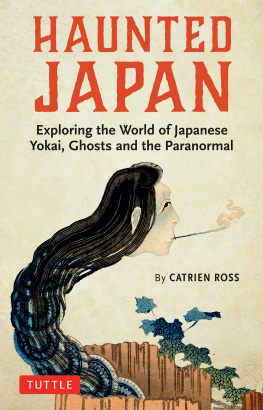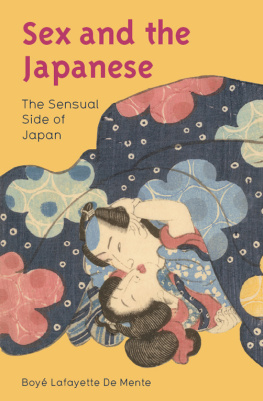ALSO BY ANTONY CUMMINS
Samurai and Ninja
Book of Samurai
Book of Ninja
Iga and Koka Ninja Skills
Secret Traditions of the Shinobi
True Path of the Ninja
Samurai War Stories
In Search of the Ninja
The Lost Samurai School
First published 2017
Amberley Publishing
The Hill, Stroud
Gloucestershire, GL5 4EP
www.amberley-books.com
Copyright Antony Cummins, 2017
The right of Antony Cummins to be identified as the Author of this work has been asserted in accordance with the Copyrights, Designs and Patents Act 1988.
ISBN 9781445663029 (PAPERBACK)
ISBN 9781445663036 (eBOOK)
All rights reserved. No part of this book may be reprinted or reproduced or utilised in any form or by any electronic, mechanical or other means, now known or hereafter invented, including photocopying and recording, or in any information storage or retrieval system, without the permission in writing from the Publishers.
British Library Cataloguing in Publication Data.
A catalogue record for this book is available from the British Library.
Typesetting and Origination by Amberley Publishing
Printed in the UK.
Western civilisation has invaded all this primitive peace with its webs of steel, with its ways of iron the old gods are dying!
Lafcadio Hearn
CONTENTS
ACKNOWLEDGEMENTS
Most translations are by Yoshie Minami and she must be thanked for her continued support and guidance; also Mieko Koizumi, who worked on translating the spells from the Zoho Majinai Chohoki Daizen document. I am grateful to Gabriel Rossa for his help with the esoteric and to Jackie Sheffield for her help with the first run-through of the text. Finally, a big thank you to David Osborne for his superb illustrations.
INTRODUCTION:
WELCOME TO HELL
The Japanese who are they? Or rather, who are they to those in the West? The masters of paper folding and car production, faceless salarymen, computer nerds and tourists machine-gunning the world with their cameras? For the generations before the war and Japans subsequent climb to economic success, the Japanese were a mysterious people; they inhabited mountains hidden by deep mists. They were a people of esoteric teachings, some aficionados of ancient ceremonies, others masters of warfare, clad in their strange armour and steeped in bloodthirsty ways. Their image was rooted firmly in the medieval and was more or less created by the Victorians. This culture, isolated from the Industrial Revolution, represented a richness that we had lost through the progress of technology. Indeed, Japan is surely unique in having once rejected a key instrument of modern technology, having given up the gun and reverted to the sword in the seventeenth century. Bearing in mind that Japan probably had more guns than any other country in the world at this time, to eliminate them almost entirely was an extraordinary achievement by the nations samurai class. But we intruded on Japan as a hidden enemy, threatening to destroy its culture. While Japan is still a cultural goldmine, it has been stripped by tourism and trade with the West and is starting to look played out.
At first Japan seems to be alive with tradition, but after years of living among the Japanese I can see the cracks beginning to show. Japan sells out its own past, and the corporate types will flog anything Japanese while we Westerners lap up the deception. In truth, when you work your way into Japanese society, it becomes clear that most Japanese have almost no idea what Japan was before the arrival of the West, in the same way as we only have a vague and media-defined understanding of our own medieval traditions. To find true beauty and culture in Japan you have to seek out real masters and faithful artisans who have a firm grasp on their particular tradition and art. It is these people who hold the threads of the old ways in their hands, but generation by generation these threads are being let loose. My aim here, if possible, is to refresh the mystery. I am searching for new avenues to rediscover the phenomenal attraction the world felt for Japan. In this volume I want to take you along the river of Hell, through cities of the damned and into the heart of all that is dark in Japanese folklore. Here I hope you will find a reminder of that distant, terrifying and beautiful land.
Pulling out the Pages
Imagine me deep in a vast castle archive or in a Japanese monastery, tearing the pages from ancient manuscripts, whispering dark spells and bringing forth images of Hell, making deals with demons and pacts with the Devil during my research. Well, no, thats not actually what happened; it was something less dramatic. Normally, I am a part of a small team that searches out and discovers ancient ninja and samurai manuals and we bring these to an English-speaking audience. At times I find myself waiting on my two trusted translators, as their part in our work takes considerably longer than mine. Thus, with time and energy to spare I began to probe for an independent project I could work on that would not create too much work for my translators. It was at this point I began to re-read some of Lafcadio Hearns work on the supernatural. Hearn (18501904), who is known in Japan as Koizumi Yakumo, was of Irish-Greek descent and spent much time in Japan. He became famous for collecting Japanese folklore and ghost stories. Reading through his work I was impressed again by the immense amount of information he had collected, but at the same time I found myself trying to bypass his Victorian travel writing. His descriptive approach is totally understandable for his day, but now there is no need for page upon page of description or commentary about the Japanese people; we can get it all on Google.
So the idea came to me. I could rediscover all those who in the Victorian era and slightly beyond recorded Japanese folklore and myths, and then preserve the essence while peeling off the Victorian redundancies. This led me on a library hunt to discover writers who from the end of the nineteenth century up until the 1950s had spent their time recording the legends of the East. A record of Japanese beliefs began to emerge, which I began to arrange for a modern audience. This has led to many parts being stripped down and overly complex cultural undercurrents being removed. During this marshalling of the material came the natural development of three categories: the hellish, the heavenly and the downright curious. This volume will concentrate on all the maleficent elements of Japanese folklore.
The old John Rylands Library on Deansgate in Manchester, the special collections branch of the University of Manchester, where I collected much of the information for this book. (Courtesy of Michael D. Beckwith under Creative Commons)
I have kept the spelling, names and place names the same as in the original works. However, I have removed all diacritical marks.
Finally, it must be remembered that these stories and legends come from all over Japan and across centuries, and therefore what was known in one area may have been unknown in another, or what was thought at one time was rejected or forgotten later. So when venturing into the dark mists of Japanese folklore, you will not always have a firm grasp of time and location.



















